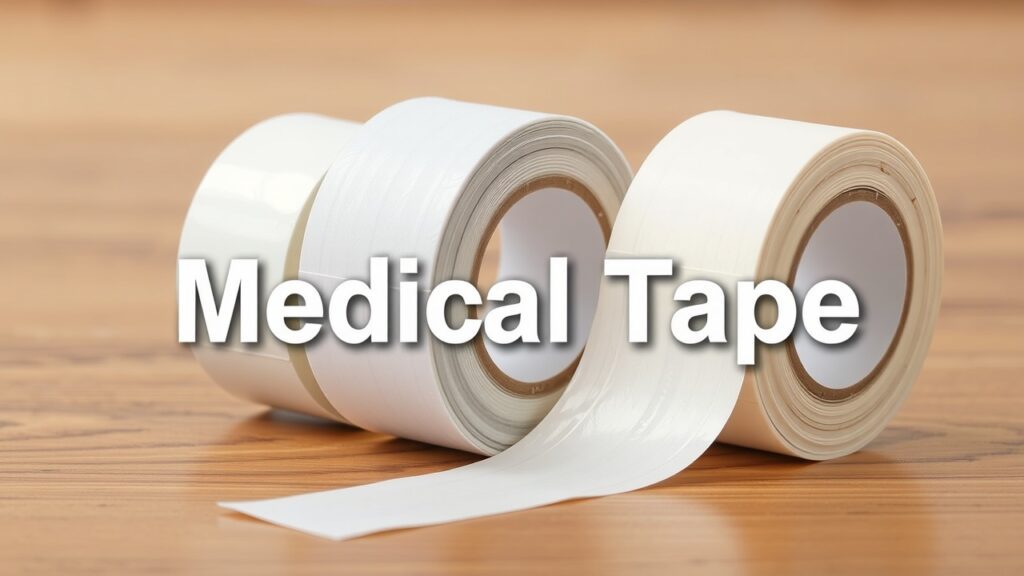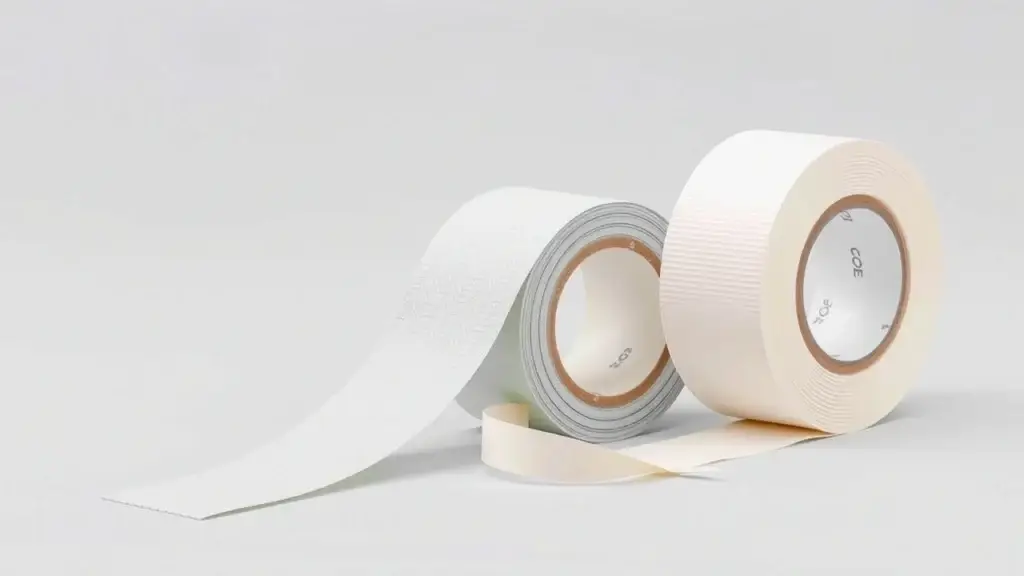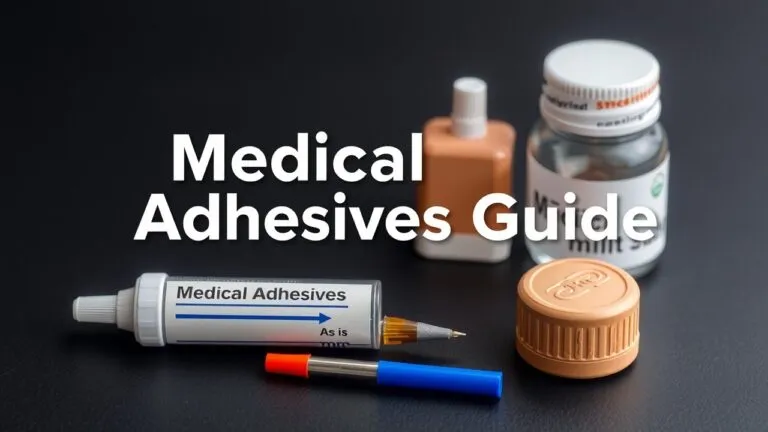Types of medical tape vary widely, from simple adhesive bandages to specialized tapes for wound dressings and skin protection. This guide helps you choose the right tape for your needs.
What Is Medical Tape?

Medical tape, or adhesive tape, is a must-have in healthcare and at home. It helps secure dressings on wounds and supports the healing process. This tape is useful for many things, like holding gauze pads over injuries or keeping IV lines in place. There are different types of medical tapes designed for various needs:
- Wound Dressing Tape: Stays put to keep dressings secure.
- First Aid Tape: Good for quick fixes and small cuts.
- Surgical Dressings: Made for use after surgeries.
Knowing which type to use can really help you take care of your injuries better.
Why Choosing the Right Medical Tape Matters?
Choosing the right medical tape matters a lot. It can change how well a wound heals and how comfortable a patient feels. The right tape keeps sensitive skin safe from irritation while making sure that dressings stick well without causing damage when removed.
If you pick the wrong tape, it could lead to issues like allergic reactions or infections. Using hypoallergenic tape can help those with sensitive skin, as it reduces risks that come with regular adhesives. It’s wise to think carefully about what type of medical tape suits your needs, whether you’re dealing with a small scrape or managing a bigger wound.
Additional Considerations
When picking out medical tape, don’t just look at how sticky it is. Consider other important factors like breathability and moisture resistance. These features play a big role in keeping wounds clean and comfy during recovery.
For example:
- Breathable Tapes let air flow through, which can help wounds heal faster.
- Moisture Barrier Tapes keep water and germs out while keeping the wound dry.
By paying attention to these details when selecting medical tapes, you can manage wound care safely and effectively.
Types of Medical Tape Explained
Paper Tape
Paper tape is lightweight and lets your skin breathe. It has a hypoallergenic adhesive, so it’s great for people with sensitive skin. You can use it for light dressing fixation, especially on non-sensitive or fragile areas.
Advantages
One big plus is that it’s super easy to apply and take off. It won’t damage the skin when you remove it.
Disadvantages
But, it doesn’t stick as well as some other medical tapes.
Cloth Tape
Cloth tape is made from strong woven fabric. It has moderate adhesion strength. This tape is best for holding dressings that need a firmer grip, especially if you’re active.
Advantages
Its flexibility means it stays in place well, even when you’re moving around.
Disadvantages
However, if used for too long, it might irritate sensitive skin.
Moleskin Tape
Moleskin tape has a soft cushion that helps prevent friction injuries like blisters. It’s perfect for areas that rub against shoes, such as your feet. You can also use it to cushion pressure points when playing sports.
Advantages
One of its best features is shock absorption. This makes it comfortable when you’re moving a lot.
Disadvantages
A downside is that it doesn’t breathe very well, which can lead to moisture buildup if you wear it too long.
Surgical Tape
Surgical tape offers strong but gentle adhesion. It’s designed for surgical uses and comes in sterile options for added safety after operations or for minor wound closures under healthcare supervision.
Advantages
It sticks reliably and helps reduce the chance of the dressing coming off while being gentle on your skin.
Disadvantages
If left on too long, it can be tough to remove without causing discomfort.
Zinc Oxide Adhesive Tapes
Zinc oxide adhesive tapes are known for their strong hold, even in wet conditions. This makes them really useful for managing wounds effectively and preventing infections.
Understanding these different types of medical tapes helps everyone choose the right one based on what they need—whether it’s securing dressings properly or providing comfort during movement.
Paper Tape Deep Dive
Detailed Composition and Characteristics
Paper tape is a soft medical adhesive made from thin paper. It sticks well but is gentle on the skin. One great thing about paper tape is that it lets air flow around a wound. This helps wounds heal and keeps them dry. This tape works really well for people with sensitive skin or those who get rashes easily.
There are hypoallergenic paper tapes for folks with skin allergies. These types are made to reduce the chance of allergic reactions. Medical adhesive tapes like paper tape come in different sizes and strengths, so doctors can pick the right one for their needs.
Specific Uses and Applications
Paper tape has many uses in hospitals and at home. It’s often used as wound dressing tape because it holds dressings in place without hurting when you take it off. In surgeries, it helps to keep things like drapes secure.
At home, people use paper tape to hold bandages on cuts or scrapes. It’s super easy to use, making it perfect for quick fixes when you get hurt.
Advantages and Disadvantages
Paper tape has its good sides and some downsides too. Here are some points to think about:
Advantages:
- It’s gentle on sensitive skin.
- It lets air reach the skin.
- Easy to apply and remove.
Disadvantages:
- Some people might get rashes from using it too long.
- The stickiness can change with different brands.
Even though it’s a good option for many, remember that not everyone will find it comfortable all the time.
Cloth Tape Deep Dive
Detailed Composition and Characteristics
Cloth tape is a type of fabric tape that many people use for medical needs. It’s made from strong woven or non-woven materials. The backing of this tape is durable, and it sticks well thanks to its strong adhesive. This means it can hold up under pressure and is really reliable.
One cool thing about cloth tape is its flexibility. It can bend easily, which helps it stick to different shapes on the body. Plus, it’s breathable, so skin underneath can get air. This makes it great for securing dressings on people who move a lot or where there’s rubbing against the skin.
Specific Uses and Applications
Cloth tape has several important uses in wound care supplies. Here are some common ones:
- Securing Dressings: It keeps bandages in place over wounds.
- Supporting Bandages: It helps keep bandages steady without stopping movement.
- First Aid Tape: Perfect for holding gauze pads on injuries while allowing the skin to breathe.
Athletes also love cloth tape. They use it to support sprains or strains during sports activities.
Advantages and Disadvantages
Cloth tape has some great benefits! For one, it protects the skin well. Its soft texture is gentle on sensitive areas, reducing irritation. Patients also find it comfortable because it moves with their bodies.
But there are a few downsides too. Some people might be allergic to certain adhesives in cloth tape. Also, if someone wears it for a long time without checking, it might cause skin problems.
Moleskin Tape Deep Dive
Detailed Composition and Characteristics
Moleskin tape is a special type of medical tape. It has a cushioned backing that makes it comfy to wear. This soft layer protects sensitive skin areas. The tape’s adhesive is strong but gentle, sticking well without hurting when you take it off. Plus, it’s durable and can handle friction while still staying in place.
Specific Uses and Applications
Moleskin tape has many important uses. Here are some key ways it helps:
- Protects high-friction areas on the body, like heels and toes.
- Prevents blisters by providing a cushion.
- Cushions pressure points during activities like walking or running.
- Covers minor injuries to keep dirt and germs out.
Advantages and Disadvantages
Using moleskin tape comes with benefits and some drawbacks.
Advantages:
- Provides cushioning to reduce pain from friction.
- Allows good movement since it fits the shape of your body.
Disadvantages:
- Can irritate sensitive skin if used too long.
- Might be hard to remove after being on the skin for a while.
Surgical Tape Deep Dive
Detailed Composition and Characteristics
Surgical tape is a special kind of tape made for medical uses. It usually has a backing made from materials like paper, cloth, or plastic. This backing works with an adhesive that helps it stick to the skin. There are two main types: sterile and non-sterile. Sterile surgical tapes are used in hospitals and places where keeping things clean is super important. Non-sterile tapes are often used at home or for less serious issues.
A key feature of surgical tape is that many are hypoallergenic. This means they are less likely to cause allergies, which is good for people with sensitive skin or allergies to certain adhesives. Different adhesive types have their own benefits; some stick better while others come off easily without hurting the skin.
Specific Uses and Applications
Surgical tape has a lot of uses in healthcare. Here are some common ones:
- Post-surgery dressings: It helps keep bandages on top of cuts, stopping germs from getting in and helping the wound heal.
- Minor wound closures: It’s handy for holding smaller cuts together when stitches aren’t needed.
- During surgeries: Tapes can hold gauze in place or secure IV lines on patients’ arms.
Medical supplies often include various types of surgical tape designed for specific jobs. Some tapes even resist water, making them perfect for situations where moisture is involved.
Advantages and Disadvantages
Surgical tape has both strengths and weaknesses.
Strengths:
- Strong adhesion keeps dressings attached, even when moving.
- Some brands make soft tapes that feel comfy on the skin.
Weaknesses:
- Long use can irritate the skin or cause damage when taking off.
- Some may not come off easily, leading to discomfort for the patient.
It’s essential to choose the right kind of surgical tape based on individual needs.
Zinc Oxide Tape Deep Dive

Detailed Composition and Characteristics
Zinc oxide tape is a special kind of medical tape. It usually has a cotton or polyester fabric backing. This backing is covered with an adhesive made from zinc oxide. This adhesive sticks well, but it’s gentle on the skin, making it perfect for sensitive areas.
One important feature of zinc oxide tape is its water resistance. It holds up well even in wet places. This is really helpful for wound care and after surgery. A lot of these tapes are hypoallergenic too. This means they are less likely to cause skin irritation or allergic reactions that can happen with other medical tapes.
Key Features:
- Adhesive Type: Zinc oxide-based
- Water Resistance: Yes
- Hypoallergenic: Often available
Specific Uses and Applications
Zinc oxide tape has many uses in healthcare. It works great as wound dressing tape because it sticks securely while allowing some air to get through. This helps protect wounds from moisture while still letting them breathe.
In surgeries, this tape can be used after the operation to hold dressings over cuts tightly. It helps keep germs out and provides a good environment for healing.
This type of tape is especially strong in moist conditions where regular tapes might not work well. Its durability makes sure it stays on even with sweat or body fluids.
Common Applications:
- Wound dressing
- Post-operative care
- Protecting incisions from infection
Advantages and Disadvantages
Zinc oxide tape comes with several benefits:
- Strong Adhesion: It sticks well without needing too much pressure.
- Skin-Friendly: It’s often hypoallergenic and less irritating.
- Water Resistant: Perfect for wet situations.
But there are some downsides too:
- Limited Flexibility: It may not fit well around bends like joints.
- Possible Residue: It might leave sticky stuff when taken off if it’s been on for a long time.
Knowing these pros and cons helps people choose the right medical adhesive for their needs.
Choosing the Right Medical Tape
Factors to Consider
When picking medical tape, think about a few key things. First, look at the type of wound and where it is. Different kinds of adhesive tape work for different purposes, like holding dressings in place or supporting injuries. Skin sensitivity is also a big deal; if someone has sensitive skin, they might need hypoallergenic tape to avoid irritation.
Also, don’t forget about patient comfort. Tapes that are too sticky can hurt when taken off, while those that don’t stick well might need more dressing changes than necessary. Lastly, consider how long you need the tape to last—some are better for short use while others can stay on longer.
Step-by-Step Application Guide
Applying medical tape correctly is important for good results and less pain for the patient. Here’s how to do it:
- Clean the Area: Use soap and water to gently clean the skin around the wound.
- Dry Thoroughly: Make sure the area is completely dry before putting on tape; moisture can make it less sticky.
- Cut Tape Appropriately: Cut a piece long enough to cover both sides of the dressing without too much overlap.
- Apply Gently: Start with one end of the tape and smooth it down towards the other end to avoid wrinkles.
- Press Firmly: After applying, press down along all edges so it sticks well.
Following these steps will help keep dressings in place and ensure proper wound care.
Safe Removal Techniques
Taking off medical tape safely is just as important as putting it on right. If not done carefully, it can hurt or damage skin:
- Start by loosening one edge gently with your fingers or scissors if needed.
- Peel back slowly at an angle instead of pulling straight up; this helps lessen tension on your skin.
- If there’s resistance due to hair or leftover adhesive, try using warm water or a special adhesive remover designed for safe removal.
Taking time with this process helps reduce discomfort from removing medical adhesives.
Addressing Allergies and Sensitivities
Some people may have allergic reactions from regular adhesive tapes due to latex allergies or other sensitivities:
- Look for hypoallergenic options that lessen the risk of allergies while still sticking well for most wounds.
- Always read labels carefully before buying if someone has known sensitivities—this includes checking for “latex-free” designs when possible.
Talking to healthcare professionals about specific needs can help keep everyone safe during treatment!
When to Consult a Healthcare Professional
While many minor wounds can be treated at home with the right medical taping methods, some situations call for professional help:
- Serious wounds needing stitches may require special surgical care instead, so always err on the side of caution!
- If there are signs of infection (like increased redness or swelling) or if pain continues despite treatment efforts—or if you’re just unsure about what to do—reach out to qualified personnel quickly!
Getting advice from healthcare providers ensures proper recovery paths based on each unique situation!
FAQs about Types of Medical Tape
What are the main types of medical tape?
The main types of medical tape include paper tape, cloth tape, surgical tape, moleskin tape, and zinc oxide tape. Each type has unique properties suited for different medical needs.
How do I choose the right medical tape for wound care?
Consider the wound type, skin sensitivity, and how long you need the tape to stick. Use hypoallergenic options for sensitive skin to prevent irritation.
Can I use regular tape for medical purposes?
No, regular tape lacks the necessary features like breathability and adhesion needed for effective wound care. Always choose medical-grade tapes.
What should I know about hypoallergenic medical tapes?
Hypoallergenic tapes reduce the risk of allergic reactions. They are suitable for people with sensitive skin or allergies to certain adhesives.
How do I remove medical tape safely?
Loosen one edge gently and peel it back slowly at an angle. This minimizes pain and prevents skin damage.
Types of Medical Tapes: Key Features and Uses
Transparent Tape
- Provides visibility of wounds while protecting them.
- Ideal for securing dressings in sensitive areas.
Breathable Tape
- Allows air circulation around wounds.
- Reduces moisture buildup to promote healing.
Absorbent Tape
- Keeps moisture away from wounds.
- Suitable for heavy exudate situations.
Self-Adhesive Tape
- Sticks to itself without needing an additional adhesive layer.
- Good for dressing retention and support.
Skin Adhesive
- Secures devices or dressings directly onto the skin.
- Excellent for ostomy supplies and IV securement.
Sterile vs Non-Sterile Tape
- Sterile tapes are essential for surgical procedures to prevent infection.
- Non-sterile tapes can be used for general wound care at home.
Moisture Barrier Tape
- Protects wounds from water and contaminants.
- Important for maintaining a clean environment around the injury.
Related Topics
- types of wound dressings
- types of adhesive tape
- types of hypoallergenic tape
- types of surgical tape
- types of breathable tape
- types of moisture barrier tape
- types of medical adhesives



Types of Medical Tape: A Guide to Adhesive Bandages, Wound Care, and More